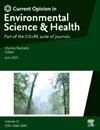Unintended effects of Bacillus thuringiensis spores and Cry toxins used as microbial insecticides on non-target organisms
IF 6.6
Q1 ENVIRONMENTAL SCIENCES
Current Opinion in Environmental Science and Health
Pub Date : 2025-02-01
DOI:10.1016/j.coesh.2025.100598
引用次数: 0
Abstract
Bacillus thuringiensis (Bt) microbial insecticides owe their effectiveness mostly to Cry toxins that target specific insects. Bt products are made of spores of Bt and crystals of toxins, Cry toxins being also used in genetically modified crops. Although widely used in agriculture, data on their long-term effects are scarce. Because microbial insecticides are essential to the development of sustainable agriculture, more research is needed to understand the unintended effects of Bt products and to improve Bt products and applications, ultimately leading to safer agricultural practices. In this review, we focus on recent studies dealing with the persistence and unintended effects of the main components of Bt insecticidal products, namely Cry toxins, spores and vegetative cells.
苏云金芽孢杆菌孢子和苏云金芽孢杆菌毒素作为微生物杀虫剂对非目标生物的意外影响
苏云金芽孢杆菌(Bt)微生物杀虫剂的有效性主要归功于针对特定昆虫的Cry毒素。Bt产品是由Bt孢子和毒素结晶制成的,这些毒素也被用于转基因作物。尽管它们在农业中广泛使用,但关于其长期影响的数据却很少。由于微生物杀虫剂对可持续农业的发展至关重要,因此需要更多的研究来了解Bt产品的意外影响,并改进Bt产品和应用,最终导致更安全的农业实践。在这篇综述中,我们重点介绍了最近关于Bt杀虫产品的主要成分,即Cry毒素、孢子和营养细胞的持久性和意外效应的研究。
本文章由计算机程序翻译,如有差异,请以英文原文为准。
求助全文
约1分钟内获得全文
求助全文
来源期刊

Current Opinion in Environmental Science and Health
Medicine-Public Health, Environmental and Occupational Health
CiteScore
14.90
自引率
0.00%
发文量
92
审稿时长
114 days
 求助内容:
求助内容: 应助结果提醒方式:
应助结果提醒方式:


